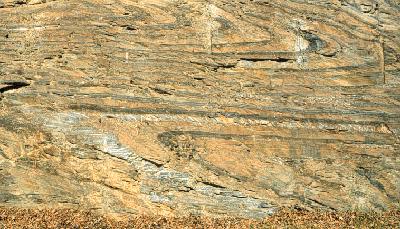
Cleavage
Folded sedimentary and metamorphic
rocks often display a fundamental internal grain known as cleavage.
The presence of cleavage in a rock permits the rock to be split into thin
plates and slabs. The term "cleavage" is difficult to define: it
broadly refers to closely spaced, aligned, planar to curviplanar surfaces
that tend to be associated with folds and oriented parallel to sub parallel
to the axial surfaces of folds. Cleavage is commonly penetrative
at both the outcrop and microscopic scales. It typically cuts bedding discordantly,
without much regard to the orientation of bedding. Cleavaged rocks
are generally folded rocks, but folded beds are not always cleavaged.
The clear geometric harmony between cleavage and folding leads to the conclusion
that cleavage forms as a response to shortening and flattening. Muscovite
is a mineral that illustrates the formation of a perfect cleavage.

Foliation
Cleavage is just a brand of foliation. Foliation
is any mesoscopically penetrative parallel alignment of planar fabric elements
in a rock, usually metamorphic rock. Wow, I can imagine it sounded so difficult,
but because the main objective of this web site is to explain to you in
easy words, here we go. "Planar fabric element" can refer to any number
of features, such as domainal structure in slaty cleavage, flattened pebbles
in a metaconglomerate, of compositional banding in a granite gneiss.
"Parallel alignment" means roughly parallel, with a lot of latitude. "Planar"
can mean perfectly planar, like a slaty cleavage surface in outcrop; curviplanar,
such as the face of a flattened, discoidal pebble in metaconglomerate;
or irregular, like the margin of a compositional band in granite gneiss
when viewed microscopically. This fold presents characteristics of
foliation in it.

Lineation
The definition of lineation, like the definiton of foliation,
is loaded with code words. Lineation is the sub parallel alignment
of elongate, linear fabric elements in a rock body, commonly penetrative
at the outcrop and/or hand specimen scales of observation, and commonly
at the microscopic scale as well. Some lineations are so penetrative
that the lineated rock looks like driftwood with a pronounced etched grain.
Other lineations are expressed in the form of such large aligned parallel
elements that it is best to refer to the lineation as linear structure.

![]()
Shear Zones and Progressive Deformation
A shear zone is a tabular to sheet like, planar or curviplanar
zone composed of rocks that are more highly strained that rocks adjacent
to the zone. The intensity with which rocks can be deformed in shear
zones is astonishing. Granites can be so strongly and thoroughly sheared
that they resemble, and have been mistakenly mapped as, metarhyolite or
metasedimentary schist. Conglomerates can be smeared out to such a degree
that individual clasts resemble thin sedimentary layers. Shear zones
have certain characteristics that permit us to recognize them in
the field, in thin sections, and on geologic maps and cross sections.
A fault zone is a shear zone formed under brittle conditions. When shear
zones form under ductile conditions, deformation is accompanied by
metamorphism and produces rocks with foliation, lineation, folds, and related
features. Some shear zones develop under conditions that are intermediate
between strictly brittle and strictly ductile deformation. This fault zone
is
a shear zone.

![]()
Plate tectonics provides a backdrop for understanding
the origin and significance of geologic structures, especially regional
structures. Plate tectonics analysis is the essential basis for interpreting
the dynamic circumstances that give rise to deformational movements.
According to plate tectonic theory, the Earth can be subdivided into discrete
fundamental "rigid" plates that move in relation to one another. A lot
happens at the boundaries and margins between plates, and within the margins
of plates. The boundaries and margins of plates typically are sites
of tectonic deformation. Notably, mountains 'build' at plate boundaries
and plate margins.
![]()